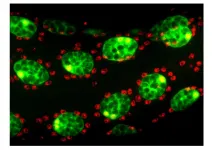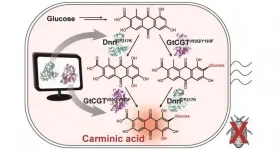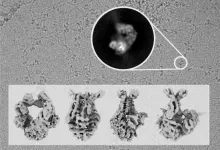(Press-News.org) Breast cancer survivors with a higher risk of cancer recurrence based on genomic testing may experience greater fear of their cancer returning, according to a new study led by researchers at NYU Rory Meyers College of Nursing. However, psychological factors such as anxiety are the best predictors of survivors' fear of their cancer recurring.
"Although genomic test results were associated with fear of cancer recurrence, our findings highlight that distressing, but treatable, psychological factors fuel cancer survivors' fear of recurrence," said Maurade Gormley, PhD, RN, an assistant professor and faculty fellow at NYU Meyers and the lead author of the study, which was published in the journal Psycho-Oncology.
For breast cancer survivors, fear and worry that their cancer will return is a significant, unmet psychological need. Over half of breast cancer survivors experience moderate to severe levels of fear of cancer recurrence; this grows to up to 70 percent among younger breast cancer survivors.
The Oncotype Dx® test is a genomic test that is used to predict the likelihood of cancer recurring in women with early-stage hormone receptor-positive breast cancer, the most common form of breast cancer. It analyzes breast cancer cells after surgery or biopsy to predict the 10-year risk of recurrence, creating a "recurrence score" that is divided into three risk categories: low, intermediate, and high. The genomic test can also be used to plan breast cancer treatment, including whether a patient will benefit from chemotherapy in addition to hormone therapy.
"We wanted to address the question of whether women with a history of breast cancer have greater fear of recurrence when they are told they are at high risk from genomic testing," said Gormley.
In the study, Gormley and her colleagues studied 110 breast cancer survivors to explore associations between the genomic test's recurrence score and its relationship to a range of factors: fear of cancer recurrence, distress, anxiety, depression, health-related quality of life, including pain and fatigue, and perceived risk of cancer recurring and spreading. They also measured women's beliefs about their illness, including their emotional response to it, perceived consequences of cancer on their lives, whether they believe they have control over their illness, and whether they perceive their cancer to be chronic.
The researchers found that breast cancer survivors with high recurrence scores reported higher overall fear and greater perceived consequences of their cancer compared to those with low recurrence scores. A greater fear of cancer recurrence was associated with higher distress, anxiety, depression, lower quality of life, and certain beliefs about their cancer, including worse perceived consequences and greater emotional response to illness.
The duration of time since breast cancer diagnosis was not associated with fear of cancer recurrence or perceived risk. However, younger women had greater fear of recurrence and worse psychosocial outcomes.
Further analyses revealed that the best predictors of whether someone was at high risk for fear of cancer recurrence were actually modifiable factors--anxiety, greater emotional response to cancer, and perceived consequences of illness--and not unchangeable factors like genomic test results and age. The modifiable, psychological factors explained 58 percent of the variance in fear of cancer recurrence.
"These findings are important because they illustrate that an individual's understanding of and response to their illness may explain who is at greatest risk for developing fear of cancer recurrence," said Gormley. "This could pave the way for developing targeted support--for instance, mental health interventions like cognitive behavioral skills--to address maladaptive beliefs about illness that occur among many breast cancer survivors."
INFORMATION:
In addition to Gormley, study authors include Tish Knobf of Yale, Allison Vorderstrasse of UMass Amherst, Brad Aouizerat of NYU College of Dentistry, Marilyn Hammer of Dana-Farber Cancer Institute, and Jason Fletcher and Gail D'Eramo Melkus of NYU Meyers. Funding was provided by the National Institutes of Nursing Research (F31NR017547).
About NYU Rory Meyers College of Nursing (@NYUNursing)
NYU Rory Meyers College of Nursing is a global leader in nursing and health. Founded in 1932, the College offers B.S., M.S., DNP and Ph.D. degree programs providing the educational foundation to prepare the next generation of nursing leaders and researchers. NYU Meyers has several programs that are highly ranked by U.S. News & World Report and is among the top 10 nursing schools receiving NIH funding, thanks to its research mission and commitment to innovative approaches to health care worldwide.
Battling other male baboons to achieve high social status comes with physiological costs that accelerate aging, according to study published today in eLife.
The findings suggest that current life circumstances may be more important contributors to premature aging than early life hardship, at least in baboons.
Chemical changes to DNA, also called epigenetic changes, can be used as a kind of 'clock' to measure aging. While these epigenetic changes usually correspond with age, they can also be used to detect signs of premature aging.
"Environmental stressors can make the clock tick faster, so that some individuals appear biologically older than their actual age and ...
OAK BROOK, Ill. - Screening with digital breast tomosynthesis (DBT) reduces the rate of interval breast cancers compared to screening with digital mammography, according to a study published in Radiology. The study adds to a growing body of evidence supporting DBT as a breast cancer screening tool with important advantages over mammography.
DBT works by capturing a series of X-ray images of the breast from different angles. Previous research has shown that it has a higher sensitivity for breast cancer detection than digital mammography.
The impact of these additional DBT-detected cancers is not fully understood. ...
OAK BROOK, Ill. - Body composition information derived from routine chest CTs can provide important information on the overall health of people with chronic obstructive pulmonary disease (COPD), including their risk of all-cause mortality, according to a study published in Radiology.
COPD is a group of chronic, progressive lung diseases like emphysema and chronic bronchitis that affect about 30 million people in the United States alone. It is frequently associated with obesity and sarcopenia, a loss of muscle mass and strength. Obesity is associated with lower mortality in patients with COPD. The longer survival rates of obese patients compared to leaner counterparts, a phenomenon ...
A statistically rigorous survey of Japanese consumers has found that they have more negative opinions about the use of new gene-editing techniques on livestock than they do about use of the same technologies on vegetables.
The survey findings were reported in the journal BMC CABI Agriculture and Bioscience on March 31st, 2021.
Because humans tend to feel closer to animals than plants, and commonly express feelings regarding animal welfare but not plant welfare, the researchers, led by Naoko Kato-Nitta, a research scientist at Tokyo's Joint Support Center for Data Science Research and Institute of Statistical ...
Even a well-characterized genome, such as that of the Drosophila the so-called fruit fly, still holds surprises. A team from the University of Geneva (UNIGE), Switzerland, in collaboration with Cornell University (USA) and the University of Groningen (Netherlands), has discovered an RNA coding for a micro-peptide - a very small protein - that plays a crucial role in the competition between spermatozoa from different males with which the female mates. In addition to shedding new light on this biological mechanism, this work, to be read in the journal Proceedings of the National Academy of Sciences (PNAS), highlights the importance of small peptides, a class of proteins that ...
Scientists of Tomsk Polytechnic University have synthetized high-entropy carbide consisting of five various metals using a vacuum-free electric arc method. The research findings are published in the Journal of Engineering Physics and Thermophysics.
High-entropy carbides are a new class of materials simultaneously consisting of four or more various metals and carbon. Their main feature lies in the capability to endure high temperatures and energy flux densities. Combining various elements in the composition, it is possible to obtain the required mix of features ...
A research group at KAIST has engineered a bacterium capable of producing a natural red colorant, carminic acid, which is widely used for food and cosmetics. The research team reported the complete biosynthesis of carminic acid from glucose in engineered Escherichia coli. The strategies will be useful for the design and construction of biosynthetic pathways involving unknown enzymes and consequently the production of diverse industrially important natural products for the food, pharmaceutical, and cosmetic industries.
Carminic acid is a natural red colorant widely being used for products such as strawberry milk and lipstick. However, carminic acid has been produced ...
El Niño-Southern Oscillation (ENSO) is one of the most prominent ocean-atmosphere interactions that varies year-to-year. This process exerts significant impacts on global weather and climate. El Niño is the warm phase of ENSO, which can be strong, moderate, or even weak. Within the past four decades, climatologists observed three super El Niño events (1982/83, 1997/98 and 2015/16). These extreme phases impacted global climate far more than moderate or weak events.
El Niño has a profound effect on the Madden-Julian Oscillation (MJO), which ...
Metamaterials that can control the refractive direction of light or absorb it to enable invisible cloaks are gaining attention. Recently, a research team at POSTECH has designed a metasurface that can control the acoustic or elastic waves. It is gaining attention as it can be used to escape from threatening earthquakes or build submarines untraceable to SONAR.
Professor Junsuk Rho of POSTECH's departments of mechanical engineering and chemical engineering and Ph.D. candidate Dongwoo Lee of the Department of Mechanical Engineering in collaboration with Professor Jensen Li of HKUST have designed an artificial structure that can control not only the domain of underwater sound but also of vibration. The research team has presented an ...
Scientists from the Genomic Integrity and Structural Biology Group led by Rafael Fernández-Leiro at the Spanish National Cancer Research Centre (CNIO) have discovered how certain proteins ensure the repair of errors introduced into the DNA during its replication. Using cryo-electron microscopy, they made the MutS protein, also known as the guardian of our genome, visible. That enabled them to describe how this single protein is able to coordinate the essential DNA repair process from beginning to end.
The study was carried out in collaboration with Meindert Lamers of the Leiden University Medical Center (LUMC, The Netherlands) and Titia Sixma of the Netherlands Cancer Institute and the Oncode Institute. Their results are published ...







